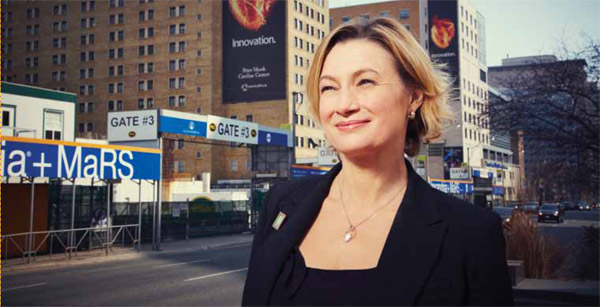What do you get when a law professor becomes a scientific director of a health research funding agency? Results

Story by Lucianna Ciccocioppo / Photography by Jeff Kirk
First published in the Spring/Summer 2011 issue of Nexus.
It’s not every day a law professor is selected for a scientific director’s job at the Canadian Institute for Health Research (CIHR).
“I was honoured when I was asked to apply, but I never thought that I would actually get it,” says Prof. Colleen Flood with a laugh. The funding agency thought otherwise.
Fresh off completing two terms, Flood is now on sabbatical and will start up again full-time at the Faculty of Law in September. Chair, research and teaching duties beckon.
But first a look back at her ground-breaking work at CIHR, promoting the vital importance of social science research as part of Canada’s health-care reform strategy.
When Flood started the job, the ‘lab guys,’ biomedical researchers and the like, were the ‘stars,’ in terms of prioritized funding. But her stellar background in law, health policy, health services and public-private partnerships soon started to change this biomedical funneling of the funds.
“I wanted to be the catalyst to improve funding to health services and policy research, and also improve the perception of its worth in the minds of our stakeholders — the government decision-makers.”
Not an easy feat, explains Flood, when taxpayers like to see splashy announcements about new MRIs or CT scans at hospitals. “It’s not so sexy to talk about the best delivery arrangement for hip or knee replacements, or the best way to organize the hospital structure.”
So Flood made it easy for the stakeholders to sit down, listen and inform themselves about the latest health policy and services research that was out there, in a program called “Evidence on Tap.”
“We asked government leaders and decision-makers: what do you need research evidence on right now? They couldn’t wait for a report one year later.” Flood and her team would identify the top leaders in the field, and bring the experts together, whether from across Canada or across the globe, for one-day intensive but informal in-camera sessions.
Evidence on Tap was piloted in Saskatchewan, Ontario and New Brunswick to great success. CIHR is now rolling it out to the remaining provinces and territories, and at the federal level as well. “A lot of what we delivered to these decision-makers is now being implemented in ongoing health-care policy and reform. It was very satisfying to see it had uptake.”
But closing the knowledge translation gap didn’t stop there. Another project put the decision-makers right on the research team. Radical? Yes — and once again successful. The idea has been copied across Canada, and in Australia and New Zealand.
But her conversation grows more animated as she lays out the largest cihr initiative she launched: a multimillion dollar project on community-based health care. “This isn’t funding research relating to the fancy hospital or specialist,” explains Flood. “This is research supporting delivery of frontline care, the nurse practitioner, the family doctor, pharmacist, and social worker, for example. It’s absolutely fundamental to a well-functioning health-care system.”
It’s a $28 million investment to fund teams of researchers Canada-wide to collaborate — rather than working in silos — on health-care delivery, and to provide comparative data at the national level. “We can see what works, and what doesn’t,” says Flood. “The primary health-care folks are just ecstatic about this project. I have all these love letters saying ‘Thank you, thank you!’”
Not bad for a law professor who acted on serendipity.


